|
I made a serious miscalculation after adding the sleeves to the shirt, and while attempting to antique the entire mass of silver to get it all the same color, I stressed the solder joints. It's been a horrible nightmare ever since, minutely inspecting every single knot and determining whether it needed repair or not. Apparently every single one of them did. This is how I marked them as I found joints that had "popped".
|
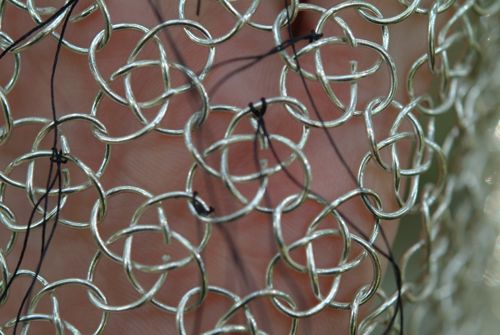
|
Since around the end of October, when this happened, I've been frantically reflowing solder joints. I tumble the shirt, then go over it knot by knot, painstakingly inspecting each one and marking the broken ones, then sitting down to the bench and reflowing them with the torch.
At first there were hundreds and hundreds each time, but now (early December) things are getting a bit better. As of this writing, the last few sessions have resulted in generally lower numbers each time: 78, 36, 38, 16, and today, 22. I'm going to have to keep at it until they're all strong enough to hold up, but at least I can realistically expect to wear it for a few days without too much trouble -- a good thing, since I'll be taking it with me to Philcon next weekend. (December 9-11, 2005).
|
|
|
I use chopsticks a lot, as my students know, and I've found that poking one into the openings of one of the knots will shape it a bit -- well, if a little bit will do good, no telling what a lot will do, right? Here are five chopsticks in a bundle, smoothed and shaped in such a way as to enter all the larger openings in the knot.
|
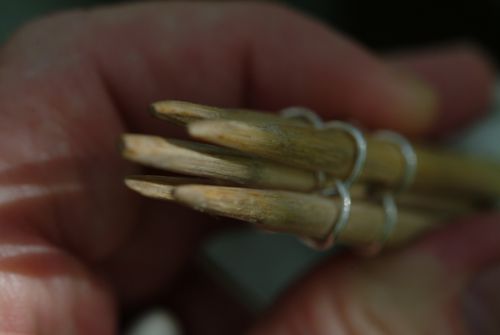
|
|
|
You can see that they're in the right alignment to work on one of the knots because they're actually held in position by the same size and shaped knot. There are two, actually, as you can tell in the above picture. Here's what it looks like end-on.
|
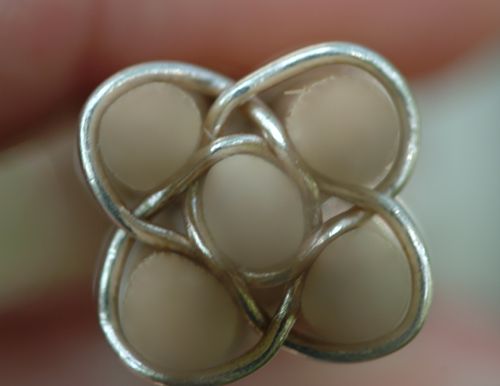
|
|
|
What I do is insert the five points into the correct spots in the target knot, then push it through until it gets really tight. You can spot the little tube that I'm using, on the other side of the sheet of knots -- it is just large enough inside to let the center chopstick in, and large enough on the outside to spread the other four, exerting even force on all four loops of the knot.
|
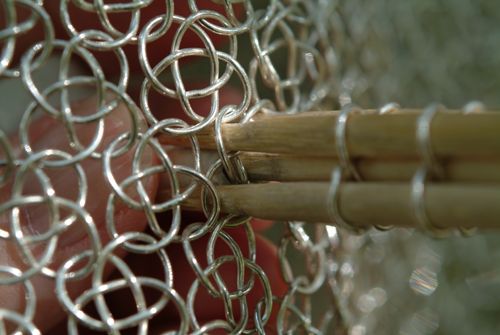
|
|
|
You can see that I have my work cut out for me... This method I've come up with is new, and I'm going back over the entire shirt with it, to make sure that every single knot is well-shaped, and has a good strong solder joint. Any knot that can stand up to this treatment is going to be fine, and any knot that breaks, well, it'll be fine after I've repaired it.
|

|
|
|
Here's a mildly misshapen knot, on the edge next to a sleeve. You can see that, while it isn't broken or bent, it isn't very even.
|
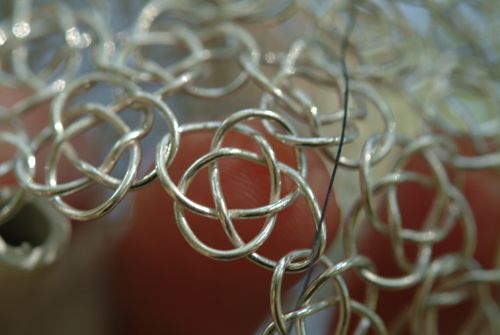
|
|
|
After pushing the fixture through it, you can see that the short loop has lengthened, and the center opening is no longer quite as distorted. Obviously, I can't expect them all to come out perfectly symmetrical, but I still think this is an improvement over what it was before.
|

|
|
|
Of all the knots I've gone over (3370, remember) there is one that looked odd to me, and I finally realized that it was tied wrong. Look at the knot that is right in the center, note that the lower right loop doesn't go under the lower left loop as it crosses. The solder joint is secure, the shape is good, and I decided to leave it alone for now.
|
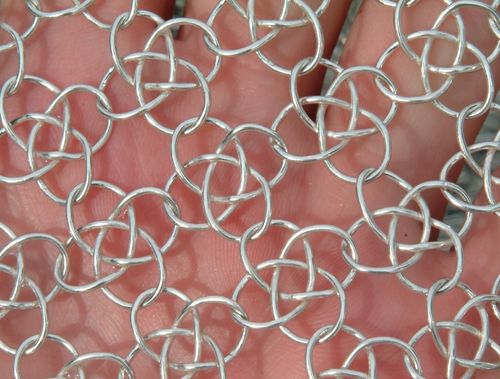
|
|
A challenge: if you see me at a convention and wish to look for the miswoven knot, I'll give you a little while to find it, say, ten or fifteen minutes. The first person to locate it gets a piece of jewelry as a prize. It's pretty clear that it is in the body, not the sleeves, and you can also see that it is at least a couple of inches away from any edges. No more hints...
|
|
In June of 2011, I was repairing broken links, which occur from time to time while I'm wearing the shirt at conventions. I mistakenly fixed the one that's tied wrong, and had to go back and un-repair it. Looks very much like it did before, so I won't change the above picture.
|
|
|








